- Engine Metals -
Properties of Existing and New Metals for Engine Applications
NOTE: All our Products, Designs, and Services are SUSTAINABLE, ORGANIC, GLUTEN-FREE, CONTAIN NO GMO's, and will not upset anyone's precious FEELINGS or delicate SENSIBILITIES
THIS IS A MODIFIED VERSION OF AN ARTICLE
BY Jack Kane WHICH APPEARED IN ISSUE 034 of
RACE ENGINE TECHNOLOGY MAGAZINE
INTRODUCTION
This article presents details on some new materials for race engine components as well as some additional engineering information on some alloys currently in use. The terms used here to define material properties and processing are explained immediately below.
BASIC MATERIALS TERMINOLOGY
Stress is a normalized method for expressing the severity of loading applied to a material. It is expressed as the applied load divided by the area to which the load is applied. For example, if a 9,800 pound tension load was applied to a 1/2-inch diameter bar (0.196 square inch cross-sectional area = diameter x diameter x 0.7854) the tensile stress would be 50,000 pounds per square inch (psi) (stress = load / area = 9800 / 0.196).
Note that this is the simplest form of stress, to illustrate the point. It does not take into account bending, shear, torsion, or any other complexities. Stress values in this article are stated in ksi, meaning thousands of pounds per square inch (300 ksi = 300,000 psi).
The Yield Stress (YS) of a given material is the stress value required to permanently stretch a test specimen a specific amount (usually 2%).
The Ultimate Tensile Stress (UTS) of a given material is the stress value required to fracture the specimen (pull it apart into two pieces). The UTS and YS values are measured on a testing apparatus designed to gradually increase the load on a specimen until it fails, and measure the deflection as the load is applied. Figures 1 and 2 show such a test before and after fracture.
 Figure 1 |
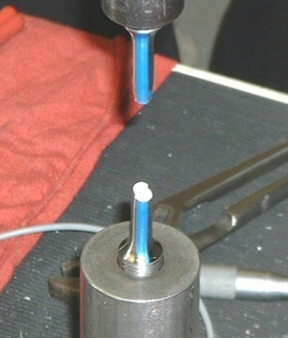 Figure 2 |
Creep is the phenomenon in which a metal, when exposed to a high stress level over an extended time period (typically hundreds or even thousands of hours) will exhibit a quasi-permanent strain (deformation), which occurs at different rates depending on the length of exposure. High temperatures generally increase the rate of creep.
Fatigue is the term used to describe the breakage of a metal part that occurs when the part is subjected to a load which varies over time, even though the varying load is well below the YS of the material. Fatigue is covered in detail on a dedicated page on this site.
There are different types of fatigue loading. One is zero-to-max-to-zero, where a part carrying no load is subjected to a specific load, then the load is removed. An example is a chain used to pull logs behind a tractor. Another type is a varying-load-superimposed-on-a-constant-load. The suspension wires in a bridge are an example of this type. The wires carry a constant static load from the weight of the bridge, plus an additional varying tensile load from the vehicles traveling across the bridge. The most severe case is the fully-reversing-load in which a specific tensile load is applied to the part then released, then a compressive load of the same value is applied and released. An example is the load applied to the roots of the teeth in an idler gear.
Fatigue tests use fully reversing loading to test the properties of materials, and the results are extremely statistical. The number of cycles a given material can survive a specific fully-reversing stress increases as the stress level decreases. Certain materials exhibit a property known as ‘infinite life’, which is defined as the fully-reversing stress level (the endurance limit, or EL) which a material can survive for 10 million applications (cycles).
Notch Toughness is a measurement of a material's resistance to breakage from impact loading. If you hit a diamond with a hammer, it will shatter; If you hit the head of another hammer with a hammer and the hammer in your hand will spring back; If you hit the fender of your car with a hammer, well you know how that turns out......
Notch toughness is measured by several different tests, the Charpy V-Notch (CVN) being one of the most frequently used. In that test, a specific size ‘V’-shaped notch is cut into a specific size rectangular bar of the test material ("specimen"), then the specimen is mounted in a testing machine which has a pendulum-type hammer. The pendulum is raised to a specific height and released. It strikes the specimen right behind the notch and fractures it. The kinetic energy (ft-lbs) contained in the pendulum at the time it strikes the specimen is easily calculated. The energy remaining in the pendulum after it breaks the specimen can be calculated from the distance it travels post-fracture. The energy required to break the specimen is obviously the difference between the two values, which is the CVN value (ft-lbs) for the material at the tested hardness.
HRc - The hardness of a material as measured on the Rockwell "C" scale. (There are several other hardness scales: Rockwell A and B, Brinell, Vickers, Knoop, Shore, etc., having different uses and ranges. HRc is the most frequently used scale for steels; HRb is a common measurement for softer metals.) Since the strength versus hardness relationship is known for each material, this test is a simple way to verify the strength of a known material.
Work-Hardening is an increase in the strength and hardness of a metal resulting from plastic deformation at a temperature below the crystal-restructuring range.
Vacuum Induction Melting (VIM) is a primary-melt process for producing very high purity steels by melting the materials by induction heating inside a high-vacuum chamber.
Electro-Slag Remelting (ESR) is an open-air remelting process through a reactive slag which produces a clean steel with good crystallography.
Pressurized ESR (PESR) is an ESR remelt but the furnace is pressurized with 1-15 bar of nitrogen to prevent the formation of oxides, producing a cleaner steel than ESR.
Vacuum Arc Remelting (VAR) is a refining process in which steels are remelted inside a vacuum chamber to reduce the amount of dissolved gasses in the metal. Heating is by means of an electric arc between a consumable electrode and the ingot, and typically takes twice as long as ESR or PESR.
It is well established that material cleanliness (absence of contaminants, oxides, bubbles, unwanted elements) is a major contributor to high fatigue life. After the primary melt, there are various remelt processes which produce an increasing level of purity in the metal. VIM-VAR is generally used to produce the cleanest (and most expensive), of double-melt steel, nickel and titanium alloys, and therefore, the best fatigue properties of double-melt methods. Triple-melt VIM-ESR-VAR produces extreme cleanliness in exchange for extreme cost.
Hot Isostatic Processing (HIP) is a method of essentially eliminating internal voids and microporosity in cast components and powder forgings. The components are put in an autoclave and heated to a temperature appropriate for the material and held for several hours while being subjected to a high pressure atmosphere of inert gas (as high as 200 bar).
MATERIAL SELECTION
The correct selection of a material for a particular application is a highly specialized field and usually requires consideration of a wide spectrum of requirements. In a race engine environment, the demands can be extreme, calling for various combinations of high strength and high fatigue resistance at high temperatures, and the minimum weight which will meet the stress and life requirements.
The perfectly-designed race engine component would operate at its design level until just after the checkered flag of the last race it was designed to run. The engineering challenge in material selection is complicated by the highly statistical nature of strength and fatigue ratings, as well as the practical problems of cost and availability. Simply stated, what is the point of specifying a 400 ksi material if it has limited availability and/or a cost that makes the target product unaffordable?
That trade-off provides the motivation to solve component-life problems by modifying the design to suit materials which are available in commercial quantities and/or for reasonable costs. The word ‘reasonable’ is highly ambiguous in the context of costs in the racing world. The 300-M which EPI, Inc. uses for highly-stressed aircraft components costs over $5 per pound, or nearly $1900 for a 10-foot bar of 2-inch round. The exotic nitriding steel (32CrMoV13) used for certain high-end crankshafts can cost over $20 per pound in the very high purity (VIM-VAR) form; over $5000 for a 26" bar of 7" round suitable for a Cup crankshaft, for example. Certain high-end PM alloys can cost over $24 per pound. Some titanium alloys cost over $60 per pound. In the nether-worlds where cost is no object (Formula One, Cup, factory Le Mans teams and the like) those numbers might not seem important, but at other levels of racing, the costs can be prohibitive.
STEELS
In the article on Crankshafts, I briefly discussed the ultra-high-strength steel known as 300-M (AMS 6419). This alloy has been used in a variety of high-strength applications including crankshafts, con rods, torsion bars and gears (not to mention various critical aircraft applications such as landing gear components). This alloy is interesting because, although it has a remarkable combination of properties (strength, fatigue life, impact resistance and ductility), it has somewhat fallen out of favor, primarily because it has been misused.
Here is an example. Suppose a company has been making successful con rods from 4340, and it decides to add a higher strength product. The engineers at the company have heard that 300-M is a great material, so they decide to use it for the new con rod. Their 4340 con rod has good strength (220 UTS / 200 YS) and impact resistance (22 ft-lb CVN) at a hardness of 44-46 HRc. However, although the strength of 4340 increases at hardness values above 46 HRc, the impact resistance becomes quite poor, so 44-46 HRc is the typical compromise hardness for 4340 cranks and con rods.
While developing their 300-M con rod, some designers have incorrectly reasoned that since 300-M is a "modified" 4340 (see Table 1), the 300-M part should be tempered back to the same hardness used for 4340 (46 HRc) to achieve good toughness. The resulting con rod has issues, and 300-M gets a bad rap.
The problem is that even though the strength of 300-M at 44-46 HRc is higher than 4340, its notch sensitivity at 46 HRc is very poor (10 ft-lb CVN).

In fact, the peak value for 300-M notch sensitivity occurs at a hardness of 53 HRc, where the value (22 ft-lb CVN) is the same as for 4340 at 46 HRc, but the 300-M has far greater strength (289 UTS / 245 YS).
At 53HRc, it is a bit more challenging to machine, but that is not a significant problem. Further, the extra carbon in 300-M allows a 60HRc surface to be produced on 53HRc through-hardened parts by induction hardening and tempering at 300°F, making it useful for some challenging gear and shaft applications. (Boeing uses a large amount of 300-M at 52-53 HRc in landing gear components.)
Recently, I heard about a new high-strength steel product from Bohler-Edelstahl, which offers potential for improvements in gearing and shafting applications. This steel, known as W-360, is a high-strength chrome-moly-vanadium alloy, having somewhat different chemistry (see Table 1) than the exotic chrome-moly-vanadium crankshaft alloy (32-CrMoV-13) discussed in my Crankshaft Design article. W-360 achieves post-heat-treat UTS/YS values of 290 / 270 ksi, with a through-hardness of 56HRc, by austenitizing at 1925°F (1050°C), oil-quenching and triple tempering at 1075°F (580°C). The alloy exhibits extremely low distortion after heat treating.
At 290 / 270 ksi UTS/YS, W-360 exhibits a 50% reduction of area (ROA) during tensile testing. As an aside: careful examination of Figure 2 reveals the ‘necking-down’ a tensile specimen undergoes just before failure. The reduction in cross-sectional area provides a quantitative measurement of a material's ductility. This phenomenon is discussed further on the Stress and Strain page.
Although W-360 already has 50 points of carbon, it can be successfully carburized, but a non-standard carbon potential is required. The high tempering temperature allows post-heat-treat nitriding and the application of PVD coatings while retaining the high core strength. With this steel, it is possible to produce a component having carburized gear teeth on one end and nitrided splines on the other.
Gears made from W-360 alloy have been successfully application-tested in an extremely-brutal form of high-end motorsport. In these applications, the best 300-M and carburized 9310 gears were failing in root fatigue from impact loading, while similar gears from W-360 survived a much longer exposure to that environment. Limited axial fatigue testing of AirMelt-PESR samples shows an endurance limit of 10^7 cycles at 138 ksi (951 mpa). One cannot help but wonder how a VIM-VAR version of this steel would perform in fatigue testing.....
SUPERALLOYS
There are some unique material selection challenges in the design of very-high-strength threaded fasteners. High-grade fasteners are exposed to high stress concentration in the thread roots caused by the tensile stresses produced from extremely high clamping loads, on top of which are superimposed any fatigue loads (as in the case of a con rod bolt).
A thread with a sharp-cornered root would be doomed to a quick failure. High-grade fasteners typically use the large full-radius fillet ‘UNJ’ thread form to minimize the stress concentrations there. Nevertheless, those radii are very small in relationship to the other dimensions of the fastener (minimum radius = 0.155 / threads-per-inch, so a 20-thread-per-inch fastener has a 0.0077" minimum radius in the root).
In order for a highly-loaded fastener to survive, the thread must be rolled with a die, producing the full-fillet thread root with a high residual compressive stress, which counteracts applied tensile stresses and adds dramatically to the fatigue life of the part.
There has been lots of research and experimentation with making ultra-high-strength threaded fasteners out of 280+ ksi quenched / tempered and maraging steels, but there have been problems with notch sensitivity, stress corrosion, fatigue, and other issues.
To solve those problems, producers looked to exotic alloys. One of the best solutions was the alloy AMS-5844 (also known as MP35N), which was initially developed for extreme corrosion resistance and strength required in hot, corrosive oil and gas drilling operations. AMS-5844 is a multiphase nickel-cobalt based alloy containing significant amounts of chrome and moly but almost no carbon or iron (Table 2). It can be work-hardened, then aged to strength levels as high as 300 ksi. The work-hardening feature lends itself to the production of very-high-strength rolled threads. Fasteners made from AMS-5844 are routinely specified for aerospace applications and in the highest levels of motorsport.
Because of the large amount of cobalt in AMS-5844, the material cost is quite high (currently around $80 per pound). To find a more economical solution that provides the same performance, a leading US fastener manufacturer (ARP) worked with Carpenter Technology to develop Custom-Age-625-PLUS (a modification of Carpenter's CA-625 chemistry).
Custom-Age-625-PLUS is a nickel-based alloy with a significant chrome and moly content, but with no cobalt, virtually no carbon and a small amount of iron. It can be work-hardened, then aged to strength levels around 270 ksi. (NOTE: Other superalloys shown in Table 2 are discussed in the article on Turbochargers.)
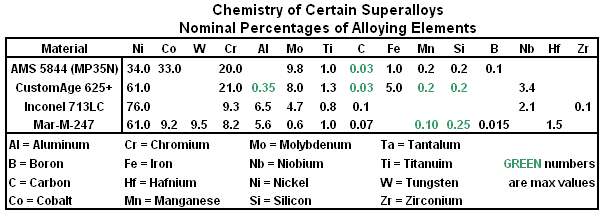
Table 2
ALUMINUM ALLOYS
Lots of ink has been used on discussions of aluminum piston material. Forged 2618 was used for piston material in Second World War aircraft engines. In certain piston engine applications, forged 4032 was preferred because of its lower coefficient of expansion. Alloy 2618 is often described as having higher strength than 4032, but at elevated temperatures (where pistons tend to operate), the strength distinction becomes quite small (Table 3). In fact, at 400°F, the 32 ksi YS of 4032 alloy is 18% higher than that of 2618 (27 ksi) at the same temperature. However, 2618 has an impressive resistance to weakening with prolonged exposure to elevated temperatures. 2618 is a copper-magnesium alloy with low silicon, but it expands with temperature about 15% faster than the high-silicon 4032 alloy. Currently, piston manufacturers seem to prefer the 2618 alloy, and many have done slight modifications either to the chemistry or to the tolerances to produce "proprietary" alloys.
There is a new family of high-strength extruded aluminum alloys currently under development by a major US titanium valve manufacturer (Del West). The members of this family are derived from existing 2000 and 7000 series wrought alloys, by a proprietary process in which existing chemistries are modified by the addition of spheroidized aluminum oxide, with the volume percentage varying between 5 and 20% depending on the targeted properties of the new material.
When compared to the base alloy, this process yields substantial improvements in the yield and ultimate stress values (10-15%) and in the fatigue performance across the usable temperature range of the base alloy, plus a significant reduction in the thermal expansion rate, and a dramatic increase in stiffness, with the elastic modulus increased as much as 40% (to nearly the value of titanium).
For example, comparing the new 2000-based alloy (‘DW 2-15’) to 2618 at 400°F, the yield strength of 2618 is 26.8 ksi, while the yield strength of the 2-15 is 32.6 ksi, an improvement of more than 21%. But that's not all. The coefficient of thermal expansion of the 2-15 alloy is 24% lower than 2618, and is even 8% lower than the "low expansion" 4032 alloy.
Fatigue testing on the 7000-based alloy (‘DW 7-15’) showed a tremendous improvement in fatigue performance compared to the very-high-strength 7075-T6. As an aside: Table 3 contains some interesting information on several often-used alloys, both wrought and cast.
The fatigue testing of the 2000-based alloys has yet to be completed. However, preliminary indications are that the results will show strength and fatigue improvements similar to the improvements realized in the 7000-series. If the expected results are verified, that will present the opportunity for yet another improvement in piston technology: strength and fatigue properties exceeding 2618 with expansion less than 4032. The materials will be available in extruded bar and plate form, with planned release in late 2008.
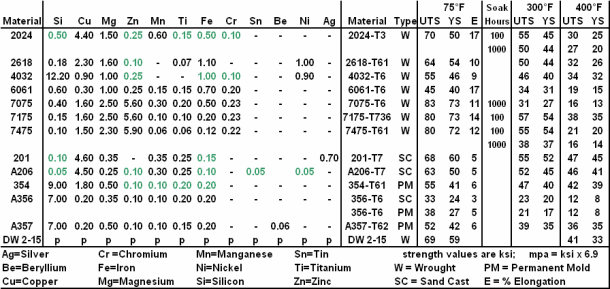
Table 3
Chemistry and Physical Properties of Some Interesting Aluminum Alloys
Table 3 contains the chemistries and some physical properties of the alloys discussed above, as well as properties of several other popular wrought and cast aluminum alloys. Of particular interest are the room temperature and elevated temperature strengths of some of the cast alloys, making them applicable to such demanding applications as turbocharger compressor wheels. Note, for example, how the strength of the famous high-strength alloy 7075-T6 drops to 37% of its room temperature value at 300°F and to less than 20% at 400°F. Also, note how the strength of 7475-T61 drops to about 26% of its room temperature value at 400°F.
MAGNESIUM ALLOYS
Magnesium is the eighth-most abundant element in the earth's crust (2.7%). Although sometimes perceived as exotic, magnesium alloys have been used for decades in both motorsport and production vehicles. For example, VW began using cast magnesium crankcases for its 1961-model, 40 horsepower flat four, air-cooled engine.
It is generally accepted that it is more difficult to successfully cast magnesium alloys than aluminum alloys, for reasons which include (a) the melt must be covered with either an inert atmosphere or with a special flux to keep oxygen away from the molten metal and (b) magnesium has a relatively low heat of fusion, which can distinctly increase the problems encountered with gating and feeding.
Certain contemporary sand-casting magnesium alloys are ideal for high-strength cast housings which are exposed to operating temperatures up to 400°F (204°C). High-strength magnesium alloys are currently used in aircraft gearboxes, WRC transmission components, and (allegedly) in Formula One engine ancillaries. A low-creep die-casting magnesium alloy is used in a new BMW production engine block.
Corrosion issues have often been seen as intimidating, but recent metallurgies plus combinations of contemporary technologies (chromating, anodizing, sealing, painting) have made the atmospheric corrosion issues much less significant. Since magnesium is highly anodic, there are galvanic corrosion issues to be dealt with, but they can be designed out.
Magnesium alloys are approximately 35% lighter than aluminum alloys, and certain alloys can be heat-treated to UTS values approaching 43 ksi, making them attractive because of their high strength / weight ratio. The stiffness of magnesium is generally only about 63% of aluminum alloys, so components being switched from aluminum to magnesium will require larger cross-sections and section moduli to achieve the same stiffness as the aluminum part, and can result in a weight saving of 20-25% depending upon the design.
There are two major magnesium alloy systems (and several others less frequently used). The first system (aluminum-zinc) is primarily targeted at high-volume die-casting requirements. These alloys contain from 3% to 10% aluminum and smaller percentages of zinc and manganese. These alloys They are widely available and modest in cost. Their mechanical properties are good to approximately 220°F, but beyond that point, begin to diminish rapidly. In the early eighties, it was discovered that if the quantity of iron, nickel and silicon (contaminants to these alloys) were kept very low, the corrosion properties of the Al-Zn alloys became quite reasonable.
Most alloys in this family are best-suited to high-pressure die-casting methods because in those processes, the die acts as a huge chill, and causes fairly rapid freezing (just a few seconds) of the melt. The rapid cooling of the melt is what gives the Al-Zn alloys their good strength properties. Conversely, extreme skill and care is generally required to obtain good sand-castings in Al-Zn alloys. The slow cooling rate which occurs in sand-casting generally provides poor material properties and inconsistent strength between thick and thin sections unless elaborate chill systems are installed in the molds.
Typically, it takes high-volume production operations to cost-justify the investment in die-casting tooling. Motorsports, on the other hand, often need relatively small numbers of castings, and therefore, rely on the lower tooling costs of sand-casting methods.
It was the need for good sand-casting magnesium alloys which provided part of the motivation for the development of the second major alloying system. That system consists of magnesium alloyed with various combinations of other elements (rare earths, zinc, thorium, silver, but NOT aluminum) to achieve a set of desired properties. This system includes a small, but essential quantity of the grain-refiner zirconium, which produces a very tiny grain size in the metal, thus giving the alloys very consistent, homogeneous properties, without the need to rely on a fast cooling rate.
These Rare Earth containing alloys have some highly desirable properties: (a) they can be sand-cast, investment-cast and extruded, (b) many of them have excellent tensile and yield values, (c) they do not depend on fast freezing rates to achieve good strength, and (d) very important is the fact that these alloys retain their room temperature strength values much better than Mg-Al-Zn and aluminum alloys at higher temperatures (see Table 4).
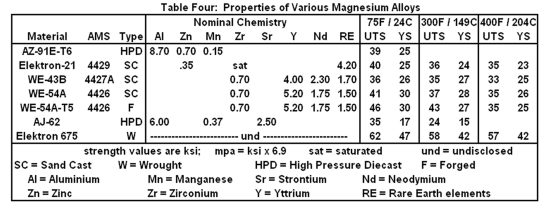
Table 4
Chemistry and Physical Properties of Some Magnesium Alloys
The alloy WE-43B is a high-strength, corrosion-resistant casting alloy specifically developed to maintain its high mechanical properties up to 570°F without using silver (which degrades the corrosion properties) or thorium (which is radioactive). When this alloy is extruded, the mechanical properties are uniform in all directions (isotropic). In the -T6 condition, it has reasonably-high room temperature properties, but the way it maintains almost constant properties up to and above 400°F is highly desirable for certain applications (see Table 4). This alloy was originally developed for the aerospace industry, and it is currently used for several helicopter transmission housings, the propeller gearbox housing on a new, very-high power turboprop engine, and in several high-end motorsport applications.
There is a recent high-strength sand-casting alloy (Elektron-21) which has room-temperature and high-temperature (to 400°F) strength properties similar to WE-43B (Table 4), but which has been specifically developed for better casting properties than WE-43B.
I was told that it is typically quite difficult to investment-cast magnesium alloys to obtain thin-wall therefore very lightweight parts. The developers of Elektron-21alloy reasoned that (a) if they could provide a high-strength alloy from which it is easier to cast successful parts,, then (b) it will be easier to make design changes, (c) the scrap rate will be lower, so (d) the overall cost of parts will decrease. Elektron-21is a high-strength alloy which is highly suitable for investment casting as well as sand-casting technology, and I have heard that it is now being used more regularly in military aircraft applications as well as WRC, MotoGP and other forms of high-end motorsport.
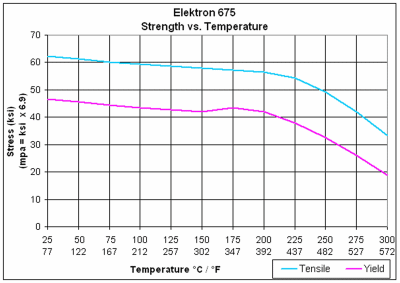
Figure 3
Elektron-675 Properties
An interesting new wrought mag-nesium alloy is currently under development. This alloy (Elektron-675) represents a step-change upward in mechanical properties. The tensile / yield values are listed as 62 / 47 ksi respectively, with initial tests showing excellent fatigue properties. The chemistry, thus the alloying system, is presently undisclosed while the patent is being sought. The strength versus tem-perature properties are shown in Figure 3, constructed from data provided by the manufacturer. This material, being in the early stages of life, is not yet available in production volumes.
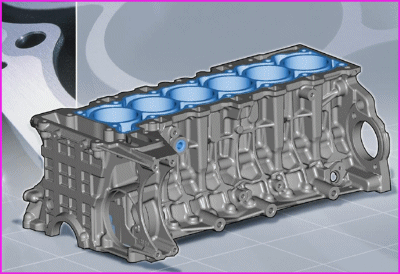
Figure 4
BMW Magnesium Block
The alloy AJ-62A is a recently developed high-pressure die-casting alloy based on the Noranda-developed magnesium-aluminum-strontium ternary alloy system, with the specific goals of providing excellent high-temperature creep resistance and excellent high-pressure die casting properties in order to avoid the problems of hot tearing, cold shuts, porosity and difficult removal from the dies.
Using this alloy, BMW developed a composite inline-6 engine block (Figure 4) which uses AJ-62 for the external block, and an aluminum alloy for the liners, coolant passages and main bearing bulkheads. This block is reported to be 24% lighter than a conventional aluminum block and contributes to BMW's claim that the R6 engine, at 161 kg, is the lightest 3.0 litre inline-six in the world.
TITANIUM
Titanium based alloys have been commercially available for just a little over 50 years. However, they have achieved widespread use in aerospace and various forms of motorsport. The valves and con rods in Formula One engines and the valves in NASCAR Cup engines are made from titanium alloys. It is used in various other applications including springs, torsion bars, fasteners, flywheels and clutch components.
Titanium is alloyed with combinations of other elements (mainly aluminum, vanadium, molybdenum, silicon, chromium, iron, zirconium and niobium) to produce titanium-based alloys metals with various physical properties. These alloys have densities which range between 0.158 - 0.175 lb/in³ (4.37 - 4.84 gm/cc), making them 56% to 62% of the weight of steel, and stiffnesses which vary between 53% to 61% of steel (15.5 to 17.7x10^6 psi). Certain alloys can be heat-treated to strengths exceeding 215 ksi (1480 mpa) UTS. Regardless of the strength levels, applications which have stiffness requirements would require a redesign to take best advantage of titanium. Unlike steel alloys, where the basic melt is an air-melt process, all titanium melting must be done in a vacuum, so the basic grades are VIM; high purity grades are VIM-VAR, and in extreme aerospace cases, there are triple-melt versions.
There are several manufacturers producing aftermarket titanium conrods. I was told by one major titanium supplier that the most frequently used alloy for conrods is the old standby Ti-6Al-4V (6% aluminum, 4% vanadium), also known as Grade 5 titanium. This alloy can be solution heat-treated and aged up to tensile strengths of 181 ksi (1250 mpa). It is interesting to note that the nomenclature "6Al-4V" has become nearly a generic, because there are more than 20 different variations available, all having the same basic chemistry but with differing melt practices, impurity tolerances, inspection requirements, etc.
I was told (by Allegheny Technologies Ltd.) about a new alloy under development that achieves a step-change in titanium material properties. This alloy was developed from the old existing alloy known as Beta-C (grade 19: Ti-3Al-8V-6Cr-4Mo-4Zr).
Whereas the commercial manufacture of Beta-C required a lengthy solution treatment and ageing cycle to achieve a tensile strength of 181 ksi (1250 mpa), this new material, using a patented process, can be cold-worked then direct-aged to a UTS over 220 ksi (1517 mpa). Even more interesting is the fatigue performance of this alloy. While the S-N (fatigue) curve for 6Al-4V continues downward as cycles increase, the curve for this material in fully-reversing fatigue (R = -1) appears to go flat at a stress level of about 93 ksi (640 mpa) at 1x10^6 cycles. This new Beta-C alloy was initially developed as a cold-winding spring alloy, but has evolved into favored usage for shafts, torsion bars and high-strength fasteners (where titanium is allowed).
Yet another interesting titanium based material is the alloy known as 15V-3Al. This is a cold-formable beta alloy produced in sheet form (1.0 - 1.5 mm thickness). Unlike many titanium alloys, this one is easily bendable to form complex fabricated sheet metal parts. When fabrication is complete, the part can be solution treated and aged, and the net result is a very high-strength, lightweight fabricated part. Imagine the possibilities for a fully-titanium monocoque chassis.
Making titanium valves survive in the harsh operating environment of a Formula One or Cup engine was a substantial challenge, especially in the case of exhaust valves, which are exposed to extremes of temperature and corrosive gasses along with high levels of fatigue loading (zero-max-zero plus bending), with quasi-impact compressive loads on the tip and seat.
To meet the challenge, the metallurgists at a major US titanium valve manufacturer (Del West) developed a proprietary, precipitation-hardening titanium alloy which begins with the tightly-controlled chemistry and melt processes of a ‘rotary’ (turbine blade) grade of Ti-6242 (6Al-2Sn-4Zr-2Mo) and the requirement for 100% virgin input (no scrap, no recycled metal). To that base, they add an undisclosed amount of silicon, which significantly improves the strength at elevated temperatures. (If there is any doubt regarding how much a small change can alter the properties of a material, compare the chemistries of 300-M and 4340 in Table 1.)
Some manufacturers make DLC-coated intake valves and spring retainers from 6AL-4V, but this manufacturer makes both its intake and exhaust valves from its proprietary version of Ti-6242. The heat treatment process is quite different for each type. The intakes are heat-treated below the beta transus temperature and subsequently quenched to form a martensitic titanium structure. That is followed by a stabilization / aging cycle at a lower temperature to achieve the desired strength properties.
The exhaust valves are heat-treated above the beta transus to produce an acicular, Widmanstätten structure (a ‘basket weave’ microstructure), which substantially improves the fatigue properties at elevated temperatures.
It has been discovered through experience that this microstructure also has crack-arresting properties. Sample exhaust valves which had been subjected to extreme mechanical and thermal loads have been found during teardown to have hundreds of tiny cracks in the stem-to-head transition area, but they had not failed in service.
These titanium valves are PVD-coated with chromium-nitride to provide the wear-resistant surfaces. Other hardcoating processes have been tried, such as controlled oxidization of the outer surface to form a hard layer of titanium-oxide. However, contrary to what was predicted by papers on that process, users of valves with that coating reported a huge loss of fatigue life, which would be expected since the TiO layer is an extremely brittle case.
More materials technology is presented in the article on turbochargers, including the use of titanium in high-temperature compressor wheels.

